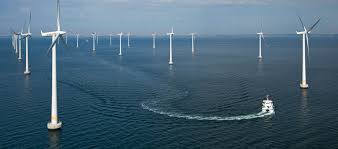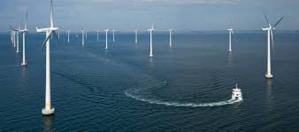With the aim to leverage their experience of deepwater development and the crowded offshore wind arena at home, some European oil majors have made inroads into the emerging U.S. offshore wind energy market.
They are looking across the Atlantic at what they view as a huge and potentially lucrative new market even as they were late entrants to the offshore wind game in Europe, which began with a project off Denmark 25 years ago and is now approaching maturity.
Norway's Statoil is retraining some oil and gas staff to work in its wind division and is marketing its new floating turbine to California and Hawaii and has won a license to develop a wind farm of the New York coast.
While Denmark's DONG Energy, a wind energy pioneer which agreed to sell its oil and gas business in May, holds a lease off the New Jersey coast and has opened an office in Boston and is in a Massachusetts-based offshore wind consortium, the Royal Dutch Shell bid for a lease offshore North Carolina earlier this year.
Ironically, it was only after the election of President Donald Trump that offshore wind generation began in the United States late last year. He battled against an offshore wind farm near his Scottish golf resort, complains about subsidies for renewable energy and is skeptical about climate change.
While more seabed leases are planned, a string of federal seabed leases were awarded before Trump took office. One of the biggest obstacles is that the investment needed to get projects going.
"Undeniably, offshore wind is a big boys' game because it requires large amounts of capital because scale is such an important cost driver," said Samuel Leupold chief executive of DONG Energy's offshore wind business.
In common with their U.S. counterparts, have so far steered clear of U.S. offshore wind, Statoil and Shell are still firmly rooted in fossil fuels and other major European oil companies, while DONG has shifted decisively toward renewables.
Uncertainty over the projects prevails U.S. federal subsidies expire at the end of 2019 and that is no means certain even though Washington estimates its potential at 2,000 gigawatts (GW), many times anticipated capacity in Europe of 25 GW by 2020.
While offshore wind farms are still multi-billion dollar projects, DONG has bene able to place a zero subsidy bid earlier this year as costs in Europe have fallen to a low level. And the price tags would be kept high as the bigger turbines needed to compete without subsidies and due to a push into deeper U.S. waters.
Many say that U.S. oil companies are waiting for a time when government support is not needed when it comes to offshore wind even though they have some investments in solar and onshore wind.
"Chevron supports renewables that are scalable and can compete without subsidies," said Morgan Krinklaw, a spokesman for Chevron, which owns an onshore wind farm.
(Source:www.reuters.com)
They are looking across the Atlantic at what they view as a huge and potentially lucrative new market even as they were late entrants to the offshore wind game in Europe, which began with a project off Denmark 25 years ago and is now approaching maturity.
Norway's Statoil is retraining some oil and gas staff to work in its wind division and is marketing its new floating turbine to California and Hawaii and has won a license to develop a wind farm of the New York coast.
While Denmark's DONG Energy, a wind energy pioneer which agreed to sell its oil and gas business in May, holds a lease off the New Jersey coast and has opened an office in Boston and is in a Massachusetts-based offshore wind consortium, the Royal Dutch Shell bid for a lease offshore North Carolina earlier this year.
Ironically, it was only after the election of President Donald Trump that offshore wind generation began in the United States late last year. He battled against an offshore wind farm near his Scottish golf resort, complains about subsidies for renewable energy and is skeptical about climate change.
While more seabed leases are planned, a string of federal seabed leases were awarded before Trump took office. One of the biggest obstacles is that the investment needed to get projects going.
"Undeniably, offshore wind is a big boys' game because it requires large amounts of capital because scale is such an important cost driver," said Samuel Leupold chief executive of DONG Energy's offshore wind business.
In common with their U.S. counterparts, have so far steered clear of U.S. offshore wind, Statoil and Shell are still firmly rooted in fossil fuels and other major European oil companies, while DONG has shifted decisively toward renewables.
Uncertainty over the projects prevails U.S. federal subsidies expire at the end of 2019 and that is no means certain even though Washington estimates its potential at 2,000 gigawatts (GW), many times anticipated capacity in Europe of 25 GW by 2020.
While offshore wind farms are still multi-billion dollar projects, DONG has bene able to place a zero subsidy bid earlier this year as costs in Europe have fallen to a low level. And the price tags would be kept high as the bigger turbines needed to compete without subsidies and due to a push into deeper U.S. waters.
Many say that U.S. oil companies are waiting for a time when government support is not needed when it comes to offshore wind even though they have some investments in solar and onshore wind.
"Chevron supports renewables that are scalable and can compete without subsidies," said Morgan Krinklaw, a spokesman for Chevron, which owns an onshore wind farm.
(Source:www.reuters.com)






